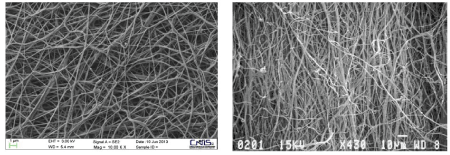
Figure 1a and 1b: Chitin Nanofibrils (left) structure compared to ECM (right), at SEM [24].


Morganti P1,2,3* Febo P4
1Professor of Skin Pharmacology, Dermatology Institute, Campania University “Luigi Vanvitelli”, Naples, Italy*Corresponding author: Morganti P, Professor of Skin Pharmacology, Dermatology Institute, Campania University, Naples, Italy, Tel: 390815666833; E-mail: pierfrancesco.morganti@mavicosmetics.it
On the one hand the skin is the largest organ in the human body, representing the first natural barrier against external agents, on the other hand personal care, sanitary, and biomedical products with a global market value of over USD 47 billion, are designed for its direct protection and treatment.
Among products and tools used for skin care, the non-woven biodegradable tissues made by natural biomaterials and innovative tissue engineering play a pivotal role in the market needs. Thus, the goal of EU research project polybioskin is to use bio-based polymers, in substitution of petrol-based ones, to produce sanitary, cosmetic and advanced medications skin-friendly and environmentally-friendly, as innovative products to save human health and the planet’s equilibrium and biodiversity.
The paper will report some prospected and designed solutions based on the use of polysaccharides and biopolyesters to make innovative polymers and non-woven tissues to be utilized for producing baby/elderly diapers, facial beauty masks, and advanced medications.
Regenerative medicine; Biopolymers; Baby diapers; Medical device; Facial beauty masks; Wound care; Polybioskin; Non-woven tissues; Chitin nanofibrils
Tissue Engineering and Regenerative Medicine (TERM) are linked interdisciplinary fields that, applying the principles of engineering and life science, develop biological substrates capable to restore, maintain, improve or replace the tissue/organ functions or their injured parts [1].
The basic concept of TERM is to manipulate the extra-cellular environment for enhancing the cell biological potentials for tissue regeneration. Covering a broad range of applications, it requires a deep knowledge on both cell biology and physiology and engineering materials with their own specific biochemical and physiochemical characteristics, necessary to improve or replace the global functions of damaged tissues or whole organs.
The final objective of TERM is to design versatile scaffolds in which desired cells could be seeded, having the same structural organization and biodegradability of the Extra Cellular Matrix (ECM). ECM, in fact, is a changing structure made of glycosaminoglycans and fibrillar proteins essential for most of the cellular processes. These structures, providing mechanical and anchoring support to the cells and guiding their growth and functions, may improve the physiological tissue architecture, hindering the formation of scar tissues. This is the reason of chitin nanofibrils effectiveness which, electrospun with collagen peptides, have shown to play an important role in the development, repair and homeostasis of skin tissue, thanks to its structure that mimic the native ECM (Figures 1a and 1b) [2,3].

Figure 1a and 1b: Chitin Nanofibrils (left) structure compared to ECM (right), at SEM [24].
Chitin and hyaluronic acid, fundamental component of ECM, share, in fact a quite similar backbone consisting of N-acetyl glucosamine repeating units (Figure 2).
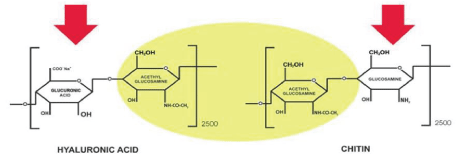
Figure 2: Chitin (left) and hyaluronic acid (right) have a similar backbone.
For all these reasons nanomaterials and nanostructures continue to attract tremendous attention worldwide and the global market of tissueengineering reached US$ 17 billion in 2013 and is expected to exceed US$ 56.9 billion in 2019 [4].
Skin regeneration is one of the goals of regenerative medicine. The skin (Figure 3) is, in fact, a complexed barrier-structure of our body, constantly exposed to potential injuries, such as external environmental harmful UV rays, micro/nanoparticles of air pollution, invasion of pathogenic and dangerous microorganisms, and internal epidermal deficiency of filaggrin with low quantity of water at the epidermal level. However, these structural and biological stress cause skin dehydration, oxidative reactions, DNA damage, metabolic deregulations or even cell death. Indirect effects may occur, in fact, through the enzymatic production of cytokines and interleukins, translated into the degradation of macromolecules, and the appearance of both inflammatory reactions and immunosuppression. When the damage is relatively low, cells trigger a repairing process, when it is of medium entity cells become senescent, and when it results excessive, they organize their own death [5]. Thus it results fundamental to protect the skin barrier by different kind of products/tools useful to accelerate the wounds repair/regeneration [6].
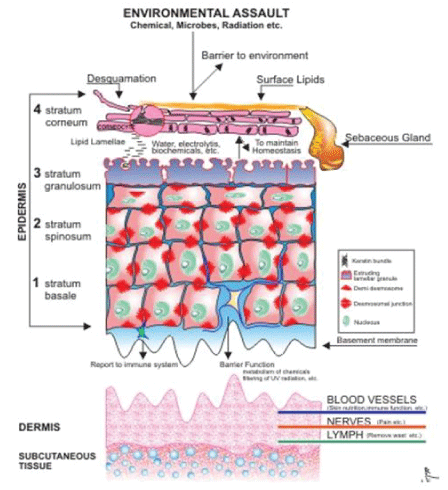
Figure 3: Skin structure and the environment.
This is the reason underpinning the PolyBioSkin European Research Project with the goal to leverage the enormous untapped potential of bio-based polymers to be used in skin-contact product applications. The fundamental aim of the project is to develop “renewable, sustainablysourced bio-based polymers, capable to offer unprecedented antimicrobial and antioxidant properties, absorbency, and skin compatibility”.
The idea is to use natural building blocks of micro/nanomolecules for creating new polymers and nanocomposites with unprecedented flexibility and improved physical properties, capable to mimicking the hierarchical composition of the skin ECM. These innovative and “activated” ECM-like polymers will be used to make non-woven tissues for skin protection, characterized for their sustainable and specific functionalities. They will be used in three strategic markets: sanitary, cosmetic and biomedical, with a global market value of over US$ 47 billion [7]. These nanostructured tissues make by the electrospinning and/or casting technology and mimicking the biological characteristics of the skin, should have the possibility to modulate cell proliferation, migration, differentiation, cellto-cell communications, and apoptosis, facilitating nutrient support and providing mechanical strengthening.
Global market for tissue and hygiene products totalled US$ 156 billion with the largest growing retail in Asia-Pacific with US$ 56.2 billion in sales, and a high increase of waste materials [8].
On the one hand the increase in import, production, and distribution cost are affecting companies that rely on imported raw materials and goods, while on the other hand the global plastic consumption (used prevalently to make the hygiene products) is expected to reach a value of 297.5 million tons, raising the waste of non degradable materials [8,9]. At this purpose, it is to remember that conventional plastics do not degrade within a short span and are a cause of land filling and sea eutrophication [Figures 4a and 4b]. On the contrary, bio-plastics are degraded rapidly by the activity of the existing environmental enzymes and human microbiome, trying to iron out these problems. Thus the necessity to look for alternative biodegradable polymers, such as cellulose, lignin, chitin and chitosan, by the use of natural raw materials obtained from agricultural and fishery’s waste respectively, for producing biodegradable plastics [10]. However, global biodegradable and eco-friendly plastic market totalled US$ 19.54 billion in 2016 and is estimated to reach US$ 65.58 billion in 2022 at an estimated CARG of 22.36% for the forecast period.
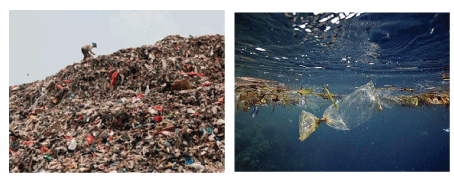
Figure 4a and 4b: Plastic pollution in both land and sea.
The reason in adoption of these environment-friendly materials is due to the increasing concerns regarding global warming, carbon emissions, ozone layer depletion, environmental hazards, and the need for reducing waste. While On the one hand land filling of plastic waste and health hazard has led to implementation of more stringent regulations regarding the use of plastic materials. On the other hand, North America and EU are expected to dominate the overall market of biodegradable materials and goods because of their conscious consumers and high-spending population.
In addition, the presence of large populations in Asia Pacific is expected to boost this market, owing also to the increase in the contract manufacturing processes coupled with increased governmental interest to promote biodegradable products by providing economical incentives in some countries, such as China and India [11]. However, the presence of huge price difference between the biodegradable and other conventional plastic materials is expected to hinder, for example, the growth of global market of biodegradable paper & bio-based plastics which totalled a value of US$ 118.7 billion in 2016 and estimated value of US$ 196.1 billion in 2021 with an incremental growth of US$ 77.4 billion [11].
The global nanotechnology-based market of medical devices is expected to grow by an 11-12% increase during the forecast period 2014- 2019, driven by the growth in population aging, the increased use of biomedical tissues, and the increase in R&D investments [12]. Moreover, the governments of several countries, such as USA, EU and Asia Pacific are investing heavily in developing and commercializing innovative medical devices, promoting the adoption of advanced nanotechnology-based nonwoven tissues and increasing the accessibility to the health care products. Thus, the wound dressing market in North America is expected to reach around US$ 14 billion with a more higher increase for the advanced medications (Figure 5).
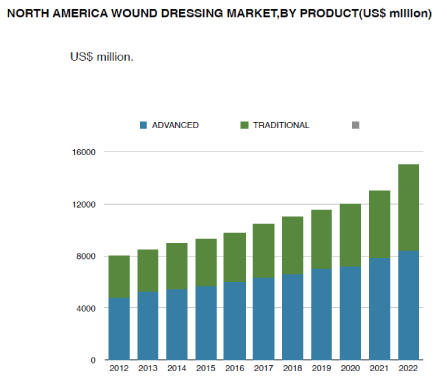
Figure 5: Provisional wound dressing market in USA.
Also for these reasons the market incorporating bio-nanotechnologies is estimated to reach US$ 3 trillion by 2020 [13]. On the other hand, the seven markets of China, India, Indonesia, Malaysia, Brazil, Egypt and Turkey are collectively projected to account for 58% of the global baby diapers and pants volume growth between 2013 and 2018, probably ranging about 95% in the next 5 years.
Regarding the industrial process for obtaining competitive fabrics, the different components required to produce the baby diapers, continue to represent a challenge for the suppliers of the non-woven tissues. The problems to be solved, in fact, are represented from the necessity to maintain a competitive cost and the consumers’ request to obtain diapers and pants with more specific performance and aesthetic properties, at a lower cost [14].
On the one hand consumers prefer ultra soft and fashioning nonwoven tissues with distinctive patterns for the top sheet and back sheet components, as well as require soft and effective fluid barrier tissues for leg cuffs. On the other hand producers, for obtaining a light weight care wrap, need to realize, a higher and better fluid transport through the different sub-layers of the tissue diapers with a low cost spunmelt non-woven tissue, with super-absorbent containment properties. These among others, the main characteristics of the different non-woven layers necessary to produce the baby diaper fabrics, competitive for their innovative properties and cost.
However, consumers today aspect good quality diapers to provide leakage protection for close to 12 hours, at the right price for both babies and elders! The same technology, in fact, may be used to produce diapers for elderly also, mainly driven by the growth in population aging. Within tissue and hygiene, one of the categories of non-woven tissue that saw the most growth, in fact, was the adult incontinence with US$ 7.2 billion in 2015 and an annual growth rate of 7%. However, the non biodegradability of these products remain unsolved, creating a heavy problem of waste disposal with severe environmental damages.
For all these reasons, the growing consumer awareness and the increasing adoption of biodegradable tissue-materials in retail outlets will have a favourable impact on the global, biodegradable diapers market. However, an increased consumer spending and the increased consumer demand for baby and adult diapers with optimized absorbent cores and soft and extensible non-woven elastic laminates at the right price, have to be clear priorities for leading manufactures. Additionally, gentle stretch performance has to endure at body temperature for up to 12 hours, providing reliable body-hugging performance, as well as the soft aesthetic of the elastic laminate could contribute to the consumers satisfaction related to the diapers quality level.
The PolyBioSkin [7] project will focus on two main classes of biobased polymers: (a) polysaccharides, such as cellulose, starch, Chitin Nanofibrils (CN) and chitosan and (b) biopolyesters, such as Poly Lactic Acid (PLA) and Poly Hydroxyl Alkanoates (PHA and PHB), all obtained from renewable resources, totally biodegradable by human and the environmental enzymes, and characterized for a reduced environmental footprint. These biobased polymers, entrapping different fillers and active ingredients to make nanocomposites, will be used to produce non-woven tissues by a green electrospinning technique using water as solvent or alternatively the casting melt-blown technology. Thus, for example, negatively charged crystal-nanocellulose (CC) will be used in combination with positive charged collagen, as well as positive charged crystalline Nanochitin (CN) will be bind to negative charged lignin.
As a consequence, the incorporation of CC, CN or their complexes into the nanocomposite will result in different reinforcement levels, depending on polymer matrix and nano filler loading. However, studying and designing in the right way the structural properties of nanocomposites and safe solvent to be used by electrospinning, it will possible to obtain non-woven tissues with physicochemical, morphological and biological properties like the native ECM. Additionally the respective incorporation of filler active ingredient into the fiber and nanocomposites structure, will allow the modification of the non-woven tissue properties, obtaining a strengthening of the fabric with a longer time of release of the incorporated ingredients.
The final obtained tissues, therefore, should have the possibility to recapitulate the native cues sensed by the cells in their natural microenvironment, interacting and regulating the cell behaviour, function, and fate. However, the goal of this research project will be to find non-woven tissues to make facial beauty masks, baby/elderly diapers, and advanced medications with an optimum between biological outcome and overall feasibility, such as product standardization, process simplicity and production cost.
Among the different raw biological-derived materials studied and controlled for the project, chitin has been selected as interesting nitrogencontaining polysaccharide that shows particular affinity with the human skin. It has the same backbone of hyaluronic acid, component of the extra cellular matrix (ECM), and resembles keratin in its structural function, differing only for its carbohydrate component (Figure 6). Moreover, this glucose-based, unbranched polymer, widely distributed in nature is commonly found in crustacean shells or insect cuticles, as well as in some mushrooms envelopes, green algae cell walls, and yeasts.
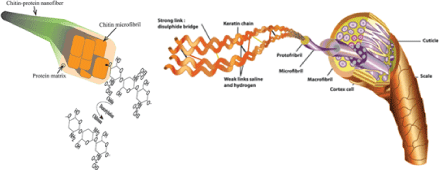
Figure 6: Chitin and keratin have the same structural function [16].
Regarding its structure, while chitin provides structural support to crustaceans tissues, keratin provides strengthening and resilience to human cell of skin, hair, and nail, supporting, for example, fibroblast attachment and proliferation in vitro [15,16]. Moreover, it is to remember that hyaluronic acid in humans and chitin and cellulose in plant, is a crosslinked polymer with the ability to swell, adsorb and hold a significant amount of water within its structure. This water is necessary to maintain the skin moisturized and young, as well as to make polyanionic gel with polysaccharides and proteins, to be used as biomaterials for replacing the damaged tissues. Moreover it is to underline that both cellulose and chitin are hierarchically organized by microfibrillar arrangements in which linear molecules are oriented in parallel manner consisting of alternated amorphous and crystalline domains. The crystal form of these natural polymers represents, naturally, their purest and reactive structure.
This is the reason why MAVI, one of the partners participating to the PolyBioSkin project, removes the chitin’s amorphous regions, by its patented process, preserving the highly crystalline domains. These nanocrystals, named Chitin Nanofibrils (CN) for their needle-like form [17] (Figure 7), have shown to possess a repair and regenerative capacity on skin tissue, accelerating the granulation process, probably because of their large-surface-area-to-volume ratio (as large as ~1000 times that of a microfiber) connected also with anti bacteria and anti-inflammatory activity [18]. CN, in fact, has evidenced an anti inflammatory activity, monitoring the level of metalloproteinases -2 and -9, being also capable to induce the synthesis of beta defensin-2, as immunomodulant peptide [19,20]. While the metalloproteinases, which increase during the aging process, are the main cause of the ECM molecules’ breakdown, the defensin-2, known as antipeptide-1, has developed the capacity to play important innate and adaptive immune responses, displaying a broad antimicrobial activity against pathogenic bacteria [19,20].
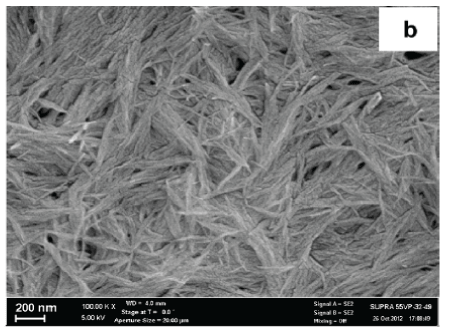
Figure 7: Crystal and needle-like structure of chitin nanofibrils at SEM [17].
These activities, characterizing the CN effectiveness in vitro as well as in vivo [21, 22], will be used to make non-woven tissue for producing baby diapers, face beauty masks and advanced medications, according to the project. Additionally CN has another interesting characteristic: it is an electropositive polymer that, easily binding electronegative polymers such as Hyaluronic Acid (HA) or Lignin (LG), is capable to entrap different active ingredients into this double-layer structures [23,24]. HA could stimulates cell transduction and other cell signalling pathways, modulating functions such as adhesion, migration, proliferation and endocytosis, while LG, for its antioxidant activity, could modulate the cell redox function.
In conclusion CN and its complexes, may act as active carrier and, as biodegradable polymer scaffolds, having a central role in tissue engineering arranging and directing cellular processes by their structural and biochemical properties. Finally, it is interesting to know that although chitin is not expressed in mammals, chitinase and chitinase-like proteins are still produced to protect humans from exogenous pathogens, which contain chitin as their structure [25]. However, chitin activates macrophages and regulates their function, according to its size. The mean size has evidenced a pro-inflammatory activity, while its small size fragment (<40 millimicrons) has shown an anti-inflammatory effectiveness (Figure 8). The anti-inflammatory activity of small sized chitin is in agreement with the results obtained from our group by the use of chitin nanofibrils, characterized by a mean dimension of 240 × 7 × 5 nm. This polymer, in fact, has shown interesting wound healing [21,22], anti-aging [23] and anti-inflammatory and antibacterial activity [18,19,24].
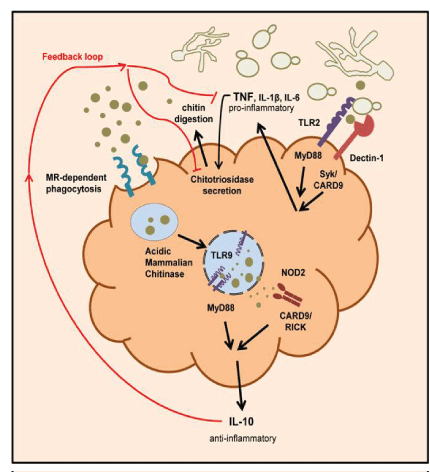
Figure 8: The Activity of chitin related to its size.
In conclusion, this natural polymer, protecting the skin from external stress-factors and preventing the cell damage, is one of the polymers that will be used to make innovative non-woven tissues for retarding premature skin aging by innovative facial masks or to repair the inflammed and wounded skin by baby diapers and advanced medications respectively.
The final goal of the project will be to use chitin, cellulose, and starch to make different non-woven tissues characterized for their antioxidant, antimicrobial and immunomodulating effectiveness, bettering both their physiochemical characteristics, such as tensile strength and mechanical barrier, and their biological and spoilage microorganisms effectiveness by the use of other biodegradable polymers such as PLA, PHA, PHB, and active ingredients entrapped into these structures. PLA is, in fact, aliphatic polyester, derived from renewable resources such as starch, while PHA (polyhydroxylalkanoate) and PHB (poly-3-hydroxybutyrate) are produced by certain bacteria processing glucose, corn starch or olive oil wastewater. All these polymers are biodegradable and skin-friendly, showing good strength and stiffness.
In conclusion, the non-woven tissues, produced by the project, have to be the capacity to support adhesion and deliver cells to the target substrate, stimulating the cellular responses. Moreover they must be bio compatible and biodegradable, made by easy, economic and sustainable industrial processes through the bioconversion of renewable lignocellulosic biomass and food industry by-products, and, naturally, to reduce pollution, respect the actual international rules and maintain in equilibrium the planet environment and biodiversity (Figures 9a and 9b), safeguarding the natural raw materials for the incoming generations.
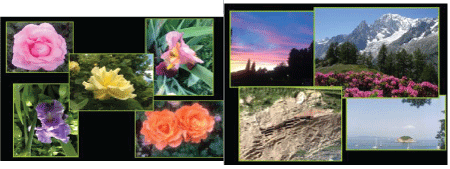
Figure 9a and 9b: Reduce pollution respecting the planet biodiversity has to be a must of our society
The project received funding from the Bio Based Industries Joint Undertaking (BBI JU) under the European Union’s Horizon 2020 research and innovation programme by the agreement No. 745839.
Download Provisional PDF Here
Aritcle Type: Review Article
Citation: Morganti P, Febo P (2017) Innovative Tissue Engineering for an Enlarged Market. J Clin Cosmet Dermatol 2(1): http://dx.doi.org/10.16966/2576-2826.119
Copyright:© 2017 Morganti P, et al. This is an open-access article distributed under the terms of the Creative Commons Attribution License, which permits unrestricted use, distribution, and reproduction in any medium, provided the original author and source are credited.
Publication history:
All Sci Forschen Journals are Open Access